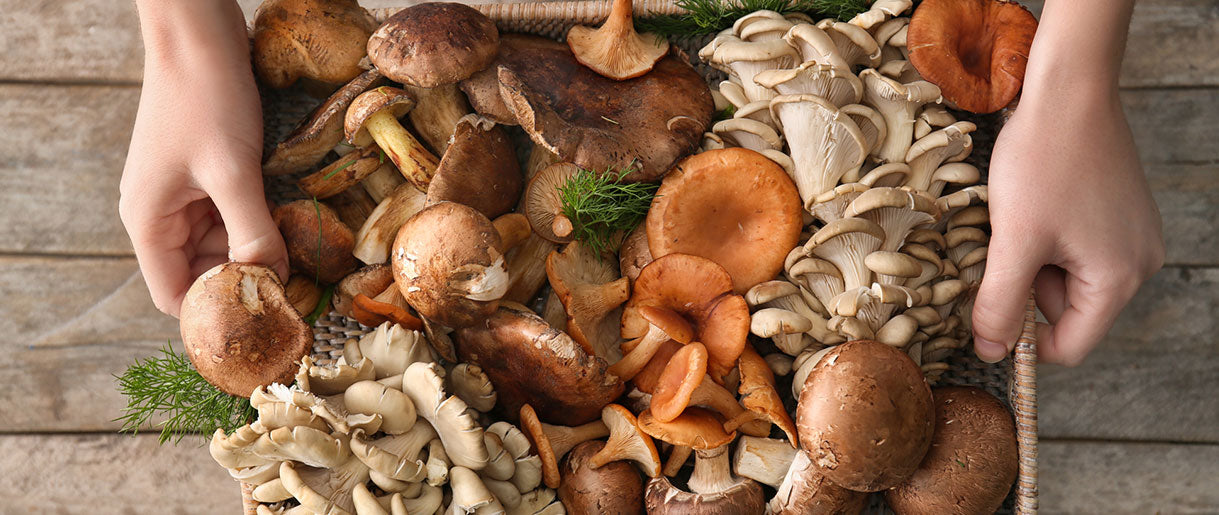Mushrooms can benefit kids' diets, providing various nutrients, including proteins, vitamins B and D, selenium, and dietary fiber. They support immune function, brain development, bone health, and digestion. Introduce mushrooms gradually into your child's diet, starting with small servings and popular, kid-friendly varieties like button or portobello mushrooms.
Cooking mushrooms thoroughly is essential for safe consumption. Get creative with kid-friendly recipes such as mushroom pasta, stuffed mushrooms, or mushroom pizzas. Always remember to consult a pediatrician or nutritionist for personalized dietary advice.
This article aims to highlight the often-overlooked benefits of mushrooms for kids and provide tips on how to introduce these versatile fungi into your child's diet seamlessly. As you'll discover, mushrooms not only add an extra layer of flavor to meals, but they can also be an exciting way to provide essential nutrients that promote growth, build immunity, and support overall well-being in children. Join us as we explore this intriguing and nutritious world of mushrooms for kids.
The Nutritional Value of Mushrooms

A Closer Look at Nutritious Food from the Fungi Kingdom
In the vegetable world, edible mushrooms hold a unique place. They bridge the gap between plants and animals regarding their biological structure, and their nutritional content is equally unique. Whether you prefer cultivated mushrooms from mushroom farms or enjoy the thrill of mushroom hunting for wild mushrooms, the nutritional value remains impressive.
Nutritional Breakdown of Most Mushrooms
While identifying mushrooms for consumption can seem daunting, the reward is a nutrient-dense food supporting overall health. The mushroom facts you need to know include their rich content of essential vitamins and minerals.
Proteins
Most mushrooms are a good source of proteins, essential building blocks for muscles and body tissues. These proteins are essential in the case of developing children.
B Vitamins
Mushrooms are a source of B vitamins like B2 (riboflavin), B3 (niacin), and B5 (pantothenic acid), which support the metabolism and the nervous system.
Minerals
Mushrooms are rich in selenium and potassium. Selenium is a powerful antioxidant that supports the immune system, while potassium aids in maintaining heart and nerve function.
Vitamin D in Mushrooms: A Unique Feature in the Vegetable World
One of the most exciting mushroom facts is that they are one of the few non-animal sources of vitamin D. The vitamin D in mushrooms varies, but certain varieties can provide nearly a day's recommended intake in a single serving when exposed to UV light.
When exposed to sunlight, mushrooms can synthesize vitamin D, which is crucial for bone health and immune function. Given that vitamin D in mushrooms can significantly contribute to children's daily needs, it's an excellent addition to their diet.
The Importance of Mushrooms for Kids: More than Just a Fruiting Body

As parents, we constantly seek nutritious food to boost our children's health and development. A closer look into the world where mushrooms grow reveals some surprising benefits. Whether cultivated or wild, edible mushrooms bring a unique taste and texture to our plates and hold numerous health benefits for our little ones.
Immunity Warriors: The Role of Mushrooms in Supporting the Immune System
A key mushroom fact that stands out is their potential to enhance immunity. The polysaccharides, particularly beta-glucans found in the cell walls of many mushrooms, are known to boost immune responses.
These compounds can stimulate the immune system, enhancing its ability to fight pathogens. This is why including edible mushrooms, such as the common white button mushroom, in your child's diet can help support their overall health.
Fuel for the Brain: Fostering Cognitive Development with Mushrooms
Mushrooms, particularly those grown in nutrient-rich environments, are a good source of B vitamins like niacin and pantothenic acid. These vitamins play a crucial role in brain development and function.
They aid in the production of neurotransmitters and support overall brain health. For example, Lion's Mane mushroom boosts memory and overall cognitive health. Lion's mane boosts neurogenesis, which helps the body generate more brain cells. Whether you're using fresh or dried mushrooms, including them in your child's diet can contribute to their cognitive development.
Building Healthy Bones with Vitamin D-Rich Mushrooms
When exposed to sunlight, mushroom caps can synthesize vitamin D—a feature not commonly found in the plant kingdom. Vitamin D is essential for absorbing calcium and phosphorus in our bodies, which are critical for developing strong, healthy bones.
Because mushrooms are one of the few non-animal sources of vitamin D suitable for human consumption, they can be a valuable addition to your child's diet, especially for those following vegetarian or vegan diets. With mushroom powder containing Vitamin D, helping your kids achieve their daily requirements is effortless.
Championing Digestive Health with Mushrooms
Another beneficial mushroom fact relates to their dietary fiber content. Mushrooms improve gut health, which in turn promotes overall health.
Many varieties of mushrooms, including cultivated ones, are a good source of dietary fiber. Fiber aids digestion by adding bulk to the diet, promoting regular bowel movements, and reducing the risk of constipation. By growing mushrooms for your child's meals, you are taking steps towards ensuring their digestive health.
Debunking Myths About Mushrooms: A Reality Check

Mushrooms, despite their diverse and highly nutritious profiles, are often subject to various misconceptions. These myths can prevent parents from incorporating this fungus into their children's diets. Here, we aim to debunk some common myths about mushrooms, equipping you with factual information so you can make an informed choice about their inclusion in your child's meals.
Myth 1: All Wild Mushrooms are Poisonous
This is perhaps the most pervasive myth about mushrooms. While it's true that there are many poisonous species in the wild, not all wild mushrooms are harmful. However, accurate identification is crucial.
Consuming wild mushrooms without expert knowledge can indeed be dangerous. Therefore, unless you are an expert in mushroom identification or are accompanied by one, it's safer to stick to mushrooms grown on farms or cultivated mushrooms available in grocery stores.
Myth 2: All Mushrooms Called 'Toadstools' are Poisonous
The term 'toadstool' is often used to refer to any mushroom that is assumed to be poisonous, and they're often portrayed as such in folklore and popular culture. The mushroom facts, however, state otherwise.
'Toadstool' is not a scientific term, and there's no clear distinction between what is classified as a 'mushroom' and a 'toadstool.' The edibility of a fungus depends on the species, not the terminology. For instance, the popular cremini mushroom could be called a toadstool, but it's completely safe to eat.
Myth 3: Cultivated Mushrooms are Not as Nutritious as Wild Mushrooms
There's a common misconception that cultivated mushrooms lack the nutritional content found in their wild counterparts. The truth is both wild and cultivated mushrooms are packed with nutritional benefits.
The exact nutritional content can vary depending on the type of mushroom, but rest assured, whether you choose cultivated mushrooms like cremini or a wild variety, both can be a nutritious addition to your child's diet.
Myth 4: All Mushrooms Taste the Same
People often assume that all mushrooms taste the same, but this is far from the truth. As with fruits and vegetables, different types of mushrooms have distinct flavors and textures.
This diversity makes mushrooms a versatile ingredient in various dishes, offering an array of flavors to suit different taste buds. For example, the Lion's mane taste is much different from the taste of Chaga mushroom tea.
Myth 5: Mushrooms are a Type of Plant
Despite being a common component in many vegetable dishes, mushrooms are not plants but a type of fungus. They don't have chlorophyll and don't undergo photosynthesis.
However, this doesn't make them any less nutritious. Mushrooms have a unique nutrient profile that benefits our health, making them an excellent addition to our diets.
Choosing the Right Mushrooms: Your Guide to Kid-Friendly Fungi

Mushrooms come in various shapes, sizes, and flavors, and not all mushrooms are created equal regarding the best fit for your child's plate. Here is a guide to choosing safe and popular mushroom varieties that kids usually love and tips on selecting the freshest and safest options.
Popular Kid-Friendly Mushroom Varieties
Button Mushrooms
Also known as white mushrooms, these are the most commonly consumed variety. They have a mild taste and a soft texture that is perfect for kids trying mushrooms for the first time.
Cremini Mushrooms
Often called baby bellas or brown mushrooms, cremini mushrooms are a bit firmer than button mushrooms and have a slightly richer flavor. They're great in soups, stews, and stir-fries.
Portobello Mushrooms
These are mature cremini mushrooms with a large cap perfect for grilling or baking.Their meaty texture makes them a good substitute for meat in vegetarian dishes.
Shiitake Mushrooms
These mushrooms have a rich, earthy flavor that can enhance various dishes. They're usually available dried but can also be found fresh.
Tips for Selecting Fresh and Safe Mushrooms
Regarding selecting mushrooms at the store or market, here are a few tips to ensure you're bringing home the freshest and safest options:
Check the Appearance
Fresh mushrooms should have a firm texture with no visible blemishes or spots. The surface should be dry but not dried out and not slimy or sticky.
Smell the Mushrooms
They should have a fresh, earthy smell. If they smell sour or unpleasant, they're likely past their prime.
Check the Gills
Fresh mushrooms' gills (the ridges underneath the cap) should be intact and not look wet or slimy. For more information on the gills, please read our detailed guide on mushroom anatomy.
Packaged vs. Loose
Packaged mushrooms should not have condensation inside the package. If buying loose, select individually to ensure quality.
Storing at Home
Keep mushrooms in a paper bag in the refrigerator. Avoid washing them until ready to use them, as excess moisture can speed up spoilage.
Tips on Introducing Mushrooms to Your Child's Diet: Making Fungi Fun

Introducing new food to children can sometimes be challenging, and mushrooms are no exception. But you can make the experience enjoyable and successful with creativity and patience. Here are some tips on introducing this nutritious ingredient to your child's meals.
Starting Small: The Gradual Introduction
Begin by introducing mushrooms in small quantities and in familiar dishes. This could be a small amount finely chopped and added to pasta sauces, scrambled eggs, or incorporated into a veggie-packed soup. As your child becomes more accustomed to the texture and taste of mushrooms, you can gradually increase the quantity and introduce them as a standalone ingredient.
Make It Fun: Mushroom Adventures
Make the introduction of mushrooms a fun activity. Take your child to a local farmer's market and explore the different types of mushrooms together, talking about their unique shapes and colors. You could also consider growing your mushrooms at home using a kit—a fun, educational activity that will excite your child about eating something they've helped grow.
Recipe Ideas: Making Mushrooms Child-Friendly
When cooking mushrooms, there are countless kid-friendly mushroom recipes you can experiment with. Here are a few ideas:
Mushroom Pizza
Use whole, halved, or sliced mushrooms as a pizza topping. Pair them with other child-friendly toppings like cheese, tomatoes, and bell peppers.
Stuffed Mushrooms
Hollow out large button or portobello mushrooms and fill them with a mix of finely chopped veggies, cheese, and breadcrumbs before baking.
Mushroom Pasta
A creamy mushroom pasta can be a hit with kids. Use a variety of mushrooms for added texture and flavor.
Mushroom Skewers
Thread whole button mushrooms, bell peppers, and cherry tomatoes on skewers, brush them with a little oil, and grill them for a fun and healthy snack.
Mushroom Omelette
Add finely chopped mushrooms to your child's morning omelet or scrambled eggs for a nutritious start to their day.
Remember, every child is unique and will have their own pace in trying and accepting new foods. Be patient, keep the experience positive, and in time, your child might surprise you by asking for mushrooms at mealtime!
Safety Tips for Incorporating Mushrooms into Your Kid's Diet: Health First

While mushrooms are a great addition to your child's diet, there are a few safety considerations to remember. Proper preparation, foraging precautions, and awareness of potential allergies ensure your child has a safe and positive experience when trying mushrooms.
Proper Cooking: Essential for Safe Consumption
One of the most important things to remember when serving mushrooms to your child is that they should always be cooked. While an adult could eat raw mushrooms, they can be extremely tough to digest for your kids, and their cell walls are difficult to break down.
Moreover, cooking mushrooms makes them easier to digest, releases nutrients, and enhances flavor. Whether sautéing, grilling, or baking, ensure the mushrooms are cooked thoroughly before serving.
Foraging Precautions: Wild is Not Always Safe
While foraging for wild mushrooms can be exciting, it's crucial to be extremely cautious. Some wild mushrooms can be poisonous and may look similar to safe varieties. For example, Reishi has several look-alikes.
Unless you're an expert in identifying mushrooms or accompanied by one, it's best to avoid picking wild mushrooms. Stick to buying mushrooms from reputable sources like grocery stores or local farmers' markets.
Potential Allergies: Keep a Close Watch
Like with any food, children can have an allergic reaction to mushrooms. While mushroom allergies are relatively rare, they can still occur.
Symptoms may include itching, swelling, stomach upset, and in severe cases, difficulty breathing. If your child is trying mushrooms for the first time, watch for any signs of an allergic reaction. If you notice anything unusual, contact your healthcare provider immediately.
FAQs About Mushrooms for Kids
Can Babies Eat Mushrooms, And At What Age Can They Start?
Yes, babies can eat mushrooms, but it's generally recommended to introduce them after your baby has started to eat a variety of fruits, vegetables, and meats—around 8-10 months old. As with any new food, it's best to introduce mushrooms in small quantities and watch closely for any signs of allergic reactions.
Be sure to cook the mushrooms thoroughly to make them easier for your baby to digest, and always cut them into small, manageable pieces to avoid choking hazards. As always, if you have any concerns or questions about when to introduce specific foods, it's a good idea to consult your child's pediatrician.
What Is The Recommended Serving Size Of Mushrooms For Children?
The recommended serving size of mushrooms can vary based on the child's age, size, and overall diet. As a general guideline, for toddlers and young children (ages 2-8), a serving size of about 1/4 to 1/2 cup of cooked mushrooms is appropriate. A serving size for older children and teenagers can be up to 1 cup.
However, every child's nutritional needs are unique, and the amount of mushrooms (or any food) that is right for your child might be different. It's always best to consult a pediatrician or a registered dietitian for personalized dietary advice.
Can Certain Types Of Mushrooms Affect My Child's Medication?
While mushrooms are generally safe for most people to eat, they can interact with certain medications. For example, some types of mushrooms may have blood-thinning properties that can increase the effects of anticoagulant medications.
Furthermore, while research is ongoing, some medicinal mushrooms are thought to influence the immune system, potentially interacting with immunosuppressive medications.
Suppose your child is on medication, and you are considering introducing or significantly increasing the intake of mushrooms in their diet. In that case, it is always advisable to consult with your child's doctor or pharmacist first. They can provide accurate information based on your child's medical history and current medications.
Key Takeaways
In this blog post, we have journeyed through the fascinating world of mushrooms and their significant benefits for children. We've explored the abundant nutrients present in mushrooms, including proteins, vitamins, and minerals essential for growth and development. We've highlighted the vital role of mushrooms in enhancing immunity, fostering cognitive development, supporting healthy bones, and promoting digestive health.
Moreover, we debunked several mushroom myths, clearing the way to understand these fascinating fungi better. We've also offered guidance on choosing the correct mushrooms and tips on introducing them to your child's diet.
But that's not all! We've emphasized the importance of safety, from properly cooking mushrooms to understanding potential allergies and the precautions needed when foraging wild mushrooms.
Mushrooms, with their unique flavors and textures, can open up a new culinary world for children. By integrating them into your child's diet, you're broadening their food horizons and providing them with significant nutritional benefits.
So, let's get those mushroom caps onto our kids' plates and start reaping the benefits of these nutritional powerhouses!
We'd love to hear your thoughts and experiences. Have you tried introducing mushrooms into your child's diet? Do you have a favorite kid-friendly mushroom recipe you'd like to share? Leave a comment below and join the conversation!










Let Us Know Your Comments